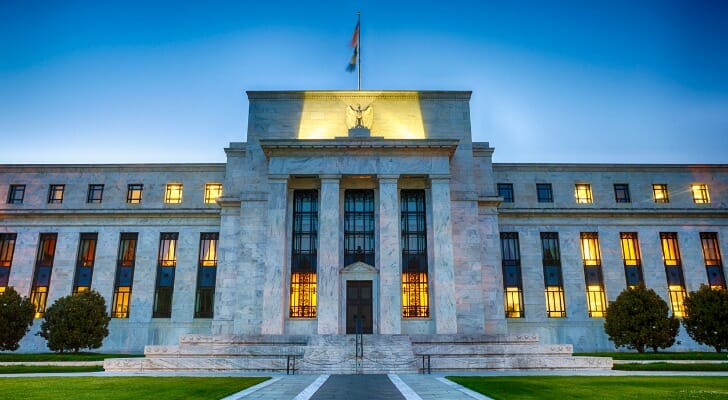The U.S. central bank, known as the Federal Reserve, has a dual mandate of managing inflation and promoting full employment. When Fed officials are said to be “dovish,” it means they are more interested in promoting job creation than in controlling wage and price inflation. They do this directly with interest rate hikes and indirectly by boosting the bank’s balance sheet through bond purchases. On the other hand, Fed officials are said to be “hawkish” when they are more interested in controlling inflation than boosting employment. They do this cutting interest rates and selling bonds. Here’s a description of dovish policies and how investors should respond.
Consider working with a financial advisor to ensure that your investment portfolio is poised to grow whether the Fed is dovish or not.
Dovish Policy Tools
The Federal Reserve Open Market Committee is a group of Fed officials who use several tools to keep unemployment and inflation in balance. These include:
Discount rates – This is the interest rate the Fed charges banks that borrow from it. When interest rates are already low, as they have been for most of the time since the 2008 financial crisis, lowering the discount rate isn’t as effective.
Reserve interest rates – The Fed also sets the interest rate that it pays banks for keeping money in reserve. When it pays higher reserve rates, banks may be less inclined to lend to businesses and consumers.
Buying and selling securities – The Fed can put more money into the system by buying bonds from banks. This is a dovish approach that will tend to reduce interest rates on loans the banks offer. The opposite of the dovish approach is sometimes called quantitative tightening.
Reserve requirements – The least-used Fed tool is raising or reducing the amount of capital that banks are required to keep in reserve to ensure stability of the banking system. A dovish approach would lower reserve requirements.
Effects of Dovish Monetary Policy
 When monetary policy turns dovish, it usually means interest rates will be going lower. As the costs of borrowing decline, businesses tend to more freely borrow to increase hiring and investments and consumers tend to borrow money to make purchases. A virtuous circle ensues: More consumer spending increases demand for products and services, so businesses boost payrolls, which in turn increases demand for goods and services.
When monetary policy turns dovish, it usually means interest rates will be going lower. As the costs of borrowing decline, businesses tend to more freely borrow to increase hiring and investments and consumers tend to borrow money to make purchases. A virtuous circle ensues: More consumer spending increases demand for products and services, so businesses boost payrolls, which in turn increases demand for goods and services.
The upshot of all this is economic growth, including more jobs and lower unemployment. But dovish policy isn’t always a good thing. As demand increases, so do prices. And, as unemployment declines, wages will also increase. If inflation in wages and prices continues rising too long, or climbs too high, the economy can overheat in an inflationary cycle.
Lower interest rates also discourage people from saving, since the return they get on savings accounts is low, and that can also have a negative effect on the economy.
Dovish Investing
When dovish hands guide monetary policy, interest rates paid by savings accounts, money market accounts and other short-term investments declines. It can be hard to find a savings account paying an attractive interest rate. In response, investors may invest in long-term fixed-income securities such as bonds to lock in the current interest rates. As rates decline while the dovish monetary policy takes effect, bonds paying higher interest become more valuable.
In a dovish monetary environment, investors may also flock to equities, especially those that pay high dividends. Thanks to increased demand for products and services, coupled with low borrowing costs, shares of companies that sell consumer products are also likely to perform well.
Homebuilding is an example of an industry that often prospers when interest rates are low, since most home purchases are financed with loans. Commodities producers, such as mining companies, may also produce good returns, as rising inflation makes industrial metals, agricultural commodities like crops and livestock as well as lumber more valuable.
Bottom Line
 Dovish monetary policy leads to lower interest rates and more economic growth and job creation. However, it can also lead to inflation in wages and prices, even hyperinflation. When dovish policy is influencing the money supply, it can be hard to find savings accounts that pay high interest, and investors may turn to long-term bonds, real estate, commodities, industrial and precious metals and equities. Investors pay close attention to what Fed officials say to detect any shift in policy from dovish to hawkish or vice versa.
Dovish monetary policy leads to lower interest rates and more economic growth and job creation. However, it can also lead to inflation in wages and prices, even hyperinflation. When dovish policy is influencing the money supply, it can be hard to find savings accounts that pay high interest, and investors may turn to long-term bonds, real estate, commodities, industrial and precious metals and equities. Investors pay close attention to what Fed officials say to detect any shift in policy from dovish to hawkish or vice versa.
Tips for Finances
- An experienced financial advisor can help investors make wise decisions when dovish government policymakers are aiming for more jobs and lower interest rates. SmartAsset’s free tool matches you with financial advisors who can help with this job in your area in five minutes. If you’re ready to be matched with local advisors who will help you achieve your financial goals, get started now.
- The stock market can be volatile. While it’s important to watch it for patterns, you can take hands-on measures to guard your finances. For example, an asset allocation calculator can help you create and maintain a diversified portfolio that will help buffer your portfolio as the market goes through bullish and bearish phases.
Photo credit: ©iStock.com/traveler1116, ©iStock.com/Okea, ©iStock.com/Antonio_Diaz
